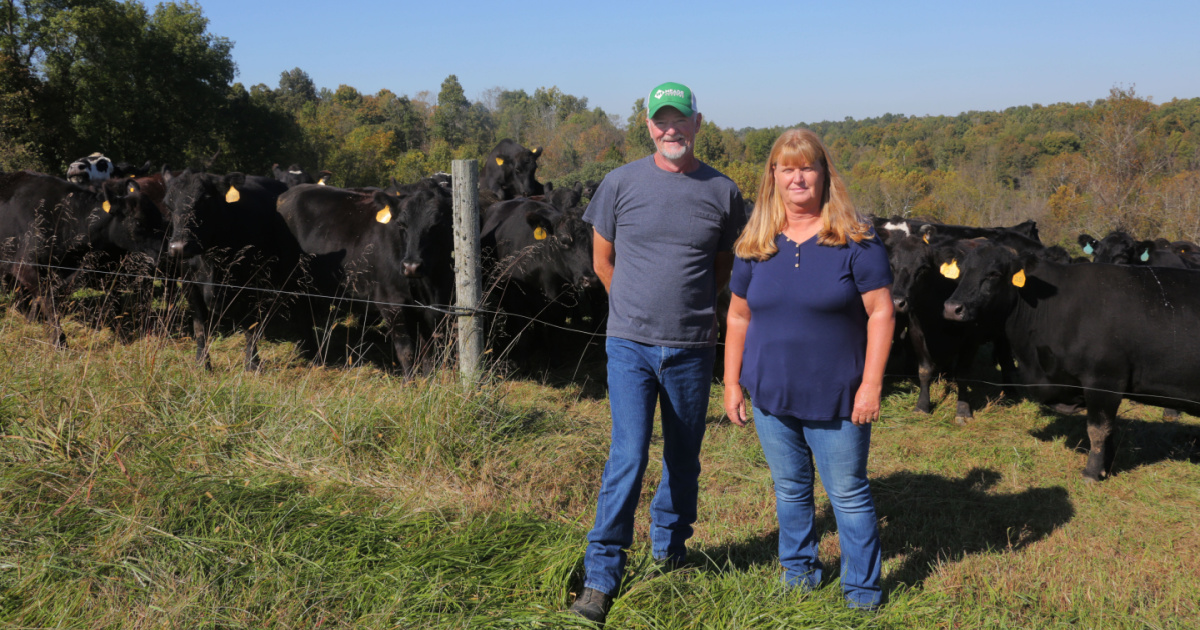Better Forages Can Lead to Better Livestock
Posted on Nov 8, 2021
Washington County couple’s cattle operation benefits from good forage management
One of the factors that makes Kentucky livestock producers so successful is the very pastures and hay fields they depend on for their animal’s nutritional needs.
It doesn’t take long into a conversation with Anthony Thompson, a cattle producer from Washington County, to realize how passionate he is about his hay and cattle. He and his wife, Amy, have spent years perfecting their operation, realizing how important of a crop their pastures are and how good pasture management has led to better cattle.
“We own about 222 acres and we have the farm split up into four to five-acre paddocks which helps us to move our cattle every day,” he said. “We began this rotational grazing probably 30 years ago before a lot of producers were doing it. But we began to see how beneficial it would be right away.”
By continually moving his cattle, Anthony said compaction is not a problem and pasture conditions are generally at an optimum level.
“I do spray to get rid of any weed issues, but I don’t use any fertilizer and haven’t used any since we stopped growing tobacco about five years ago,” he said. “And I do believe in keeping lime on the farm, but this ground has done nothing but improve since I went to rotational grazing.”
The Thompsons’ farm has become somewhat of a model, with numerous University of Kentucky College of Agriculture, Food and Environment field days have taken place there. There are also occasional visits from those who come to the farm to see their practices in hopes of starting an operation for themselves.
Renee Carrico, Kentucky Farm Bureau Livestock & Environmental Field Specialist said as she has traveled the state and had the opportunity to ride along on beef cattle operations, the one piece that always stands out is the focus on quality forages to result in better cattle.
“As producers begin to manage their pastures as a true ‘crop’, it seems like the overall quality and management of the cattle herd also improves,” she said. “Even after growing up on a farm with intensely managed grazing practices, it never ceases to amaze me how making time to move a couple of poly wire fences each summer and holding cows off specific pastures in the fall, can lead to feeding a bale or two less hay that same winter. The immediate result is incredible, and possible for any size producer.”
Anthony also takes care of 130 acres for his own hay as well as numerous acres for his custom rolling business. He said the weather this year created plenty of hay for the coming winter months.
“I've got a lot of extra hay to sell and we just had so much extra pasture because of all the rain we had, and it’s not only with me but we have rolled so much more hay this year for all of our customers,” he said. “It will be a bad year to sell hay because everyone has plenty, but I’d rather be in that situation than have a drought.”
The Thompsons also have the benefit of city water being on the farm and they have fenced off all pond water to keep the cattle out.
“The cows like the city water and, because we can keep them out of the ponds, we don’t have as many with foot problems, which saves on veterinarian bills and keeps our cattle heathier,” Anthony said.
This farming couple sees their pastures as crop land and do everything they can to ensure they have a good crop year after year, and because of those efforts, they have been able to grow their herd without using more land to do so.
“We've got about 70 cows, four bulls and 19 replacement heifers getting ready to go in the herd in the fall,” Anthony said. “We mostly have a fall calving season and have about 54 babies on the ground with about 72 feeders.
The Thompsons have more than doubled the number of cattle they have for what pasture they’ve got, crediting rotational grazing.
“We have healthy pastures and healthy cattle and can keep the cattle on the pastures until January or sometimes February,” Anthony said. “Then we’ll take them to the two feed pads we have until spring and the pastures begin to green up again.”
The Thompsons have set the example of how to take their existing resources, make them better to improve their pastures, and improve their cattle, which ultimately makes for a better business.
“We are fulltime farmers and we have done a lot of things to make sure we can run the farm by ourselves,” Anthony said. “And there is no place we’d rather be.”
For more information about forages, go to http://forages.ca.uky.edu.
Comments